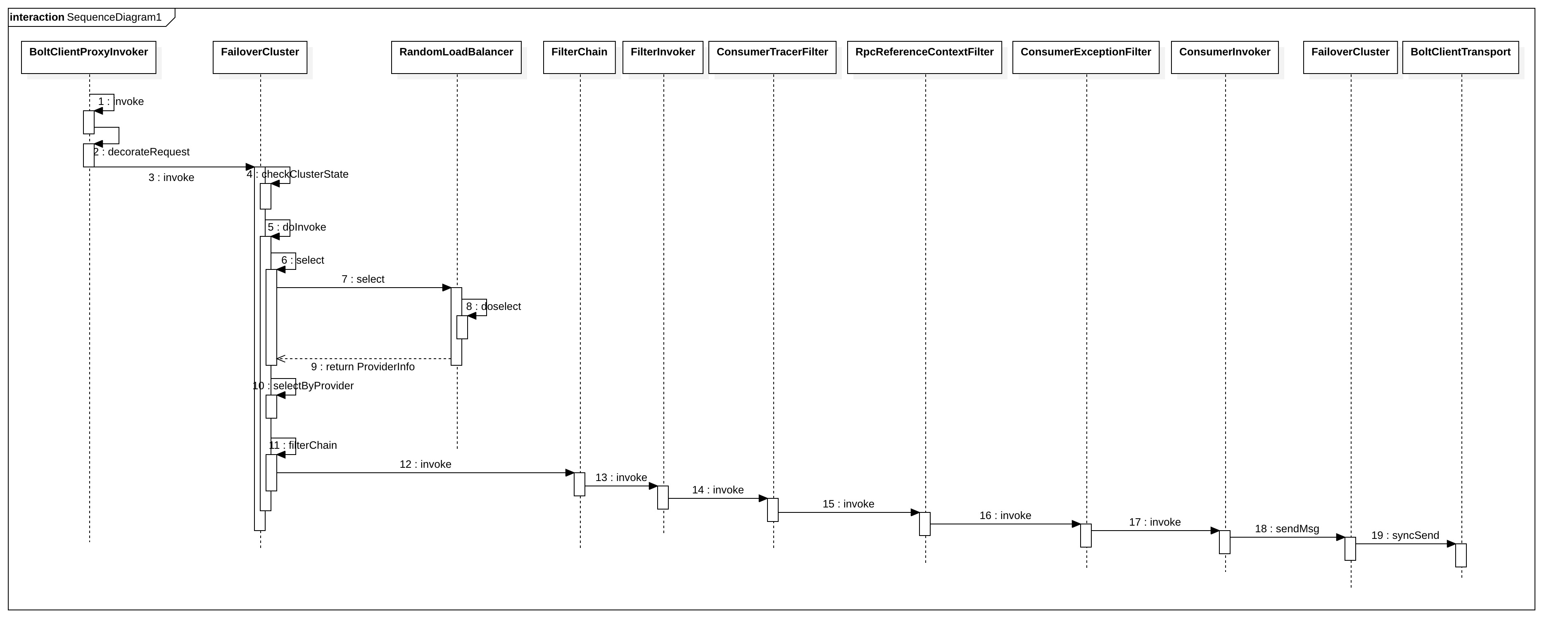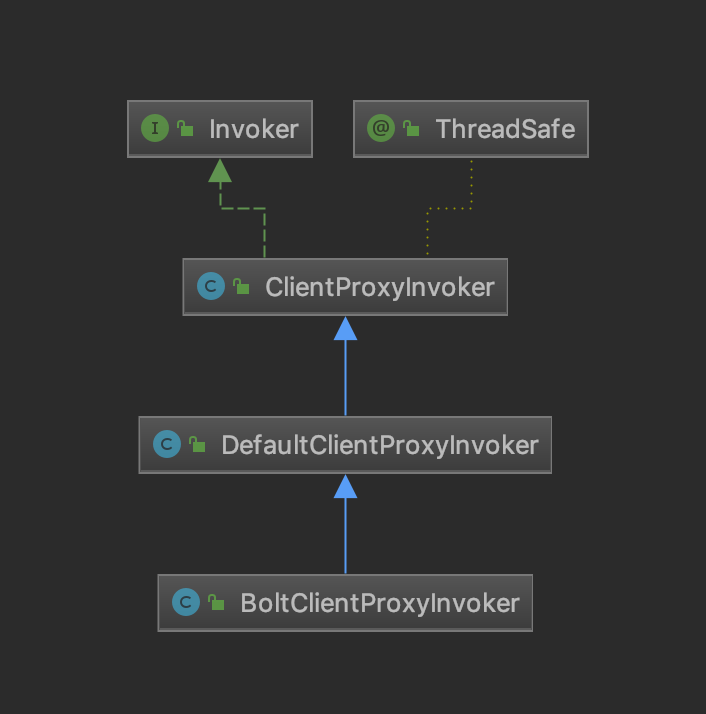
我们首先看看BoltClientProxyInvoker的关系图

所以当我们用BoltClientProxyInvoker#invoke的时候实际上是调用了父类的invoke方法
ClientProxyInvoker#invoke
@Override
public SofaResponse invoke(SofaRequest request) throws SofaRpcException {
SofaResponse response = null;
Throwable throwable = null;
try {
RpcInternalContext.pushContext();
RpcInternalContext context = RpcInternalContext.getContext();
context.setProviderSide(false);
// 包装request请求
decorateRequest(request);
try {
// 产生开始调用事件
if (EventBus.isEnable(ClientStartInvokeEvent.class)) {
EventBus.post(new ClientStartInvokeEvent(request));
}
// 得到结果
response = cluster.invoke(request);
} catch (SofaRpcException e) {
throwable = e;
throw e;
} finally {
// 产生调用结束事件
if (!request.isAsync()) {
if (EventBus.isEnable(ClientEndInvokeEvent.class)) {
EventBus.post(new ClientEndInvokeEvent(request, response, throwable));
}
}
}
// 包装响应
decorateResponse(response);
return response;
} finally {
RpcInternalContext.removeContext();
RpcInternalContext.popContext();
}
}
这个方法主要做了几件事:
- 包装request请求,设置必要的参数
- 调用FailOverCluster的invoke方法,将reques请求发送出去,并得到response相应
- 包装response响应
我们在调用FailOverCluster的时候实际上是调用的父类AbstractCluster的invoker方法,FailOverCluster关系图如下:

所以我们进入到AbstractCluster的invoker方法中:
@Override
public SofaResponse invoke(SofaRequest request) throws SofaRpcException {
SofaResponse response = null;
try {
// 做一些初始化检查,例如未连接可以连接
checkClusterState();
// 开始调用
countOfInvoke.incrementAndGet(); // 计数+1
response = doInvoke(request);
return response;
} catch (SofaRpcException e) {
// 客户端收到异常(客户端自己的异常)
throw e;
} finally {
countOfInvoke.decrementAndGet(); // 计数-1
}
}
checkClusterState方法主要是用来校验是否已销毁了,或是调用了init方法进行初始化了。
然后会在调用之前记一下数。
然后我们进入到doInvoke方法中:
public SofaResponse doInvoke(SofaRequest request) throws SofaRpcException {
String methodName = request.getMethodName();
int retries = consumerConfig.getMethodRetries(methodName);
int time = 0;
SofaRpcException throwable = null;// 异常日志
List<ProviderInfo> invokedProviderInfos = new ArrayList<ProviderInfo>(retries + 1);
do {
//负载均衡
ProviderInfo providerInfo = select(request, invokedProviderInfos);
try {
//调用过滤器链
SofaResponse response = filterChain(providerInfo, request);
if (response != null) {
if (throwable != null) {
if (LOGGER.isWarnEnabled(consumerConfig.getAppName())) {
LOGGER.warnWithApp(consumerConfig.getAppName(),
LogCodes.getLog(LogCodes.WARN_SUCCESS_BY_RETRY,
throwable.getClass() + ":" + throwable.getMessage(),
invokedProviderInfos));
}
}
return response;
} else {
throwable = new SofaRpcException(RpcErrorType.CLIENT_UNDECLARED_ERROR,
"Failed to call " + request.getInterfaceName() + "." + methodName
+ " on remote server " + providerInfo + ", return null");
time++;
}
} catch (SofaRpcException e) { // 服务端异常+ 超时异常 才发起rpc异常重试
if (e.getErrorType() == RpcErrorType.SERVER_BUSY
|| e.getErrorType() == RpcErrorType.CLIENT_TIMEOUT) {
throwable = e;
time++;
} else {
throw e;
}
} catch (Exception e) { // 其它异常不重试
throw new SofaRpcException(RpcErrorType.CLIENT_UNDECLARED_ERROR,
"Failed to call " + request.getInterfaceName() + "." + request.getMethodName()
+ " on remote server: " + providerInfo + ", cause by unknown exception: "
+ e.getClass().getName() + ", message is: " + e.getMessage(), e);
} finally {
if (RpcInternalContext.isAttachmentEnable()) {
RpcInternalContext.getContext().setAttachment(RpcConstants.INTERNAL_KEY_INVOKE_TIMES,
time + 1); // 重试次数
}
}
invokedProviderInfos.add(providerInfo);
} while (time <= retries);
throw throwable;
}
这个方法里面主要做了这这件事:
- 如果失败的话就循环调用
- 负载均衡,选取provider
- 通过过滤器链调用服务端,并返回结果
- 异常处理
接着我们进入到filterChain方法中,根据过滤器链最后会跳到ConsumerInvoker中的invoke方法
@Override
public SofaResponse invoke(SofaRequest sofaRequest) throws SofaRpcException {
// 设置下服务器应用
ProviderInfo providerInfo = RpcInternalContext.getContext().getProviderInfo();
String appName = providerInfo.getStaticAttr(ProviderInfoAttrs.ATTR_APP_NAME);
if (StringUtils.isNotEmpty(appName)) {
sofaRequest.setTargetAppName(appName);
}
// 目前只是通过client发送给服务端
return consumerBootstrap.getCluster().sendMsg(providerInfo, sofaRequest);
}
consumerBootstrap.getCluster()会返回FailOverCluster实例,然后调用父类AbstractCluster的sendMsg方法
public SofaResponse sendMsg(ProviderInfo providerInfo, SofaRequest request) throws SofaRpcException {
ClientTransport clientTransport = connectionHolder.getAvailableClientTransport(providerInfo);
if (clientTransport != null && clientTransport.isAvailable()) {
return doSendMsg(providerInfo, clientTransport, request);
} else {
throw unavailableProviderException(request.getTargetServiceUniqueName(), providerInfo.getOriginUrl());
}
}
protected SofaResponse doSendMsg(ProviderInfo providerInfo, ClientTransport transport,
SofaRequest request) throws SofaRpcException {
RpcInternalContext context = RpcInternalContext.getContext();
// 添加调用的服务端远程地址
RpcInternalContext.getContext().setRemoteAddress(providerInfo.getHost(), providerInfo.getPort());
try {
checkProviderVersion(providerInfo, request); // 根据服务端版本特殊处理
String invokeType = request.getInvokeType();
int timeout = resolveTimeout(request, consumerConfig, providerInfo);
SofaResponse response = null;
// 同步调用
if (RpcConstants.INVOKER_TYPE_SYNC.equals(invokeType)) {
long start = RpcRuntimeContext.now();
try {
response = transport.syncSend(request, timeout);
} finally {
if (RpcInternalContext.isAttachmentEnable()) {
long elapsed = RpcRuntimeContext.now() - start;
context.setAttachment(RpcConstants.INTERNAL_KEY_CLIENT_ELAPSE, elapsed);
}
}
}
// 单向调用
else if (RpcConstants.INVOKER_TYPE_ONEWAY.equals(invokeType)) {
long start = RpcRuntimeContext.now();
try {
transport.oneWaySend(request, timeout);
response = buildEmptyResponse(request);
} finally {
if (RpcInternalContext.isAttachmentEnable()) {
long elapsed = RpcRuntimeContext.now() - start;
context.setAttachment(RpcConstants.INTERNAL_KEY_CLIENT_ELAPSE, elapsed);
}
}
}
// Callback调用
else if (RpcConstants.INVOKER_TYPE_CALLBACK.equals(invokeType)) {
// 调用级别回调监听器
SofaResponseCallback sofaResponseCallback = request.getSofaResponseCallback();
if (sofaResponseCallback == null) {
SofaResponseCallback methodResponseCallback = consumerConfig
.getMethodOnreturn(request.getMethodName());
if (methodResponseCallback != null) { // 方法的Callback
request.setSofaResponseCallback(methodResponseCallback);
}
}
// 记录发送开始时间
context.setAttachment(RpcConstants.INTERNAL_KEY_CLIENT_SEND_TIME, RpcRuntimeContext.now());
// 开始调用
transport.asyncSend(request, timeout);
response = buildEmptyResponse(request);
}
// Future调用
else if (RpcConstants.INVOKER_TYPE_FUTURE.equals(invokeType)) {
// 记录发送开始时间
context.setAttachment(RpcConstants.INTERNAL_KEY_CLIENT_SEND_TIME, RpcRuntimeContext.now());
// 开始调用
ResponseFuture future = transport.asyncSend(request, timeout);
// 放入线程上下文
RpcInternalContext.getContext().setFuture(future);
response = buildEmptyResponse(request);
} else {
throw new SofaRpcException(RpcErrorType.CLIENT_UNDECLARED_ERROR, "Unknown invoke type:" + invokeType);
}
return response;
} catch (SofaRpcException e) {
throw e;
} catch (Throwable e) { // 客户端其它异常
throw new SofaRpcException(RpcErrorType.CLIENT_UNDECLARED_ERROR, e);
}
}
sendMsg方法最后会调用到doSendMsg。
soSendMsg里面主要做了如下几件事:
- 如果是同步调用,则直接返回封装好的参数
- 如果是单向调用,则调用buildEmptyResponse方法,返回一个空的response
- 如果是callback调用asyncSend,RPC在获取到服务端的结果后会自动执行该回调实现。
- 服务端返回响应结果被 RPC 缓存,当客户端需要响应结果的时候需要主动获取结果,获取结果的过程阻塞线程。